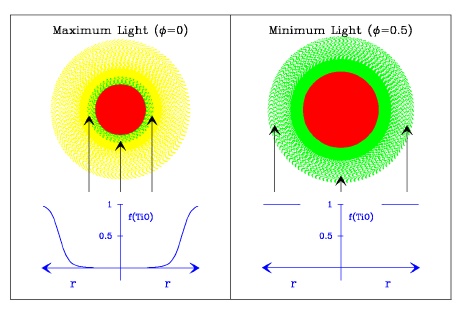
Reference: Reid & Goldston (2002, ApJ, 572, 694), or click here for a preprint.
|
Mira variables have long fascinated both amateur and professional
astronomers. In the late 1500s, European and Asian astronomers noted the
"disappearance" of a star, most likely o Ceti, over a period of months.
While this star dimmed dramatically, it did not really disappear and, in
the early 1600s, Fabricius and Holwarda recognized that o Ceti was a
variable star. Because of the extreme changes of its
brightness, o Ceti was called Mira (or "marvelous one"). Indeed, Mira
variables are marvelous; some regularly change visual luminosity by
8 magnitudes, or factors of more than 1000, over periods of hundreds
of days
Mira variables are red giant stars that have grown to enormous sizes after they finished "burning up" all the hydrogen in their outer atmosphere. These stars pulsate and change surface temperature and size by about 20%. While this is a large change for a star, it cannot directly account for the extremely large changes in visual light. Although this problem has been around for hundreds of years, it has never been directly addressed by astronomers. Josh Goldston and I have developed a simple explanation for this astounding phenomenon. In oxygen-rich (meaning there is more oxygen than carbon atoms in the stellar atmosphere) Mira variables, metallic oxides, such as titanium-oxide (TiO), form throughout the stellar atmosphere as the star cools when approaching minimum light. Metallic oxides like TiO are ingredients in some sun screen products. What happens when a star forms sun screen in its atmosphere? For Miras when this happens, the visual light can be almost completely absorbed at large radii, extending the visual photosphere to nearly twice its nominal size. At these large radii, temperatures can fall to approximately 1400 K and essentially all of the star's radiation emerges in the infrared. Since almost no optical light is emitted at these low temperatures, Mira variables can decrease their visual light by more than a thousand-fold. |

|
The figure to the left is a schematic depiction of the change
in visual appearance of a Mira
variable star at maximum (left-hand panel) and minimum
(right-hand panel) light. The star, shown in red, is
smaller and hotter at maximum light than at minimum light.
At maximum light, the extended atmosphere of the star
(shown as yellow) is partially transparent at visual wavelengths,
and one sees almost down to the stellar surface (indicated with arrows).
Near minimum light, the temperature of the star has declined and
metallic oxides, such as TiO (shown as green), form throughout the
extended atmosphere. The fraction of Ti in TiO, labelled f(TiO),
as a function of radius is plotted in blue.
Near minimum light, TiO forms with sufficient
density at about 2 stellar radii to become opaque to visible light.
At this radius, the temperature can be very low, and almost all radiation
is in the infrared. Since little visible light emerges, the star can almost
disappear to the human eye.
Reference: Reid & Goldston (2002, ApJ, 572, 694), or click here for a preprint.
|